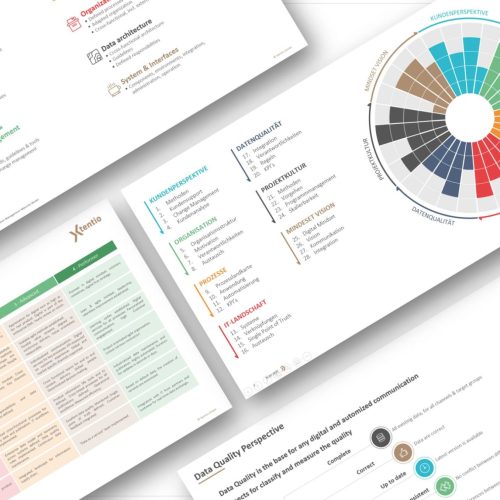In the first part of our Digital Maturity topic, we looked at data quality, processes and agility, three important criteria for assessing your company's digital maturity. In this episode, we present three other aspects that also have a major impact on the success of your digital transformation.
Successful digitization has a lot to do with skills. And that includes the expertise of your IT department. After all, without a modern, flexible IT infrastructure and skilled IT staff, digital transformation can be difficult. This simple self-test with a few guiding questions can help you determine whether IT is acting as a partner or a brake.
Another aspect is more difficult to grasp, but no less relevant: We often observe that there are no clear goals for digital transformation coming from the board and management: The "digital vision" is missing. And we don't mean the euphemistic boilerplate of many corporate mission statements, which often have little to do with the actual reality of the company. They need concrete and tangible visions of the future and goals that are both directional arrows and guard rails for new digital business models and their implementation. A compelling vision and a realistic roadmap provide understanding, orientation and motivation, so that everyone involved and affected is aware of "why" you are actually taking on the change.
It should go without saying that a constant focus on the needs and requirements of your existing and future customers is a key success factor for new, digital business models. But in our experience, digitization projects too often focus on improving and securing internal processes: compliance, data security, efficiency, cost reduction. But it also means that we are miles away from new, disruptive business models and market opportunities. For this reason, a company's customer focus also plays an important role in our assessment of digital maturity.
In this episode, we therefore take a closer look at these three success factors:
Vision and image of the future
Formulate clear goals for successful digitization! These questions will help you determine whether your organization's management is setting the right guardrails and framework.
Customer orientation
Who do we really want to digitize for? Use these guiding questions to determine whether you are driving customer-centric digital products and services - or stewing in your own juices.
IT Management
Without well-positioned IT, the digital transformation will be difficult. These key questions can help you determine how well your IT department is prepared to meet current and future challenges.

“Es ist schon ernüchternd, how seldom the concrete needs the customers
be at the center of digitization projects"
Marco Hoff, Senior Consultant at Xtentio GmbH

Vision and image of the future
You don't become a digital champion by being "laissez faire."
A clear, coordinated and robust vision of the future is the basis for all necessary strategic decisions and plans. If this central and comprehensible "why" is not present, there is a risk of getting lost in uncoordinated digitization initiatives, and even the most motivated colleagues will resign at some point if they no longer understand the meaning behind them. If you can answer "yes" to the following questions, your organization's leadership has already laid an important foundation for successful digitization.
- Does your company have a long-term corporate vision or a long-term view of the future ("Where do we want to be in 5 to 10 years?")?
- Are there specific qualitative goals for "digital transformation" in this vision?
- Is the vision actively represented, considered, and modeled by management?
- Is the vision well known in the organization and supported by employees?
- Is there a clear strategy and long-term roadmap for the digital transformation of the company?
- Are new digital business models a central part of the vision, strategy, and roadmap?
- Is there transparent goal management and regular planning and measurement of goal achievement, e.g. using methods such as OKR?
Customer orientation
The customer must be at the center - even in digital transformation.
When processes and services are digitized, the focus is often on increasing efficiency. After all, the change should benefit the company and its employees. This does not automatically result in a direct benefit to the customer. Optimal customer experience is therefore at the heart of all digital transformation considerations, strategies, and projects. If you answered "yes" to these questions, you can expect your customers to benefit from the changes.
- Does your company regularly conduct customer surveys and market research?
- Does your company have formalized and lived processes for continuous improvement of products and services?
- Do your customers actively participate in requirements management and in the development and improvement of products and services?
- Is there dedicated, high-quality customer support that meets your customers' needs for accessibility, response time, and quality?
- Are there processes and systems in place to collect and evaluate customer feedback?
- Is customer feedback being incorporated into digital transformation plans?
- Do your information supply chains meet your customers' needs for easy and convenient product selection, smooth ordering processes and reliable logistics?
IT management
High-performance IT systems and infrastructures are the engine of digitization.
Today, digital transformation is often understood in this way: Everything in the cloud, and everything will be fine. But even then, systems must interact and data must flow smoothly. Leftover legacy systems1, poor interfaces and an overstretched IT organization can therefore ruin even the best concepts and business ideas. If you answered "yes" to the following questions, your machine room seems to be in order.
- Is your IT organization capable of supporting emerging digital business models with skilled people, organizational agility, and the adoption of new practices and collaboration models?
- Are legacy systems no longer used for central tasks in your company?
- Do your systems communicate with each other in real time, for example, through service-oriented architectures, technologies, and interfaces?
- Is there a close and permanent strategic and operational link between business units, IT projects and IT operations (business-IT alignment)?
- Do you incorporate feedback from external and internal customers to continuously improve IT applications, systems, and infrastructure?
- Does your IT have a complete and up-to-date overview of all systems and applications operated in the company, for example via a central Enterprise Architecture Management? Enterprise Architecture Management?
- Do your IT technologies and services meet the needs of internal and external customers for resilience, compliance, performance, usability, and data security?
Score
Answered 18 to 21 questions with yes?
That looks pretty good already! Your leadership provides clear direction and sets the framework for a successful digital transformation focused on the needs of your customers. And your IT is clearly prepared to meet the challenges of new digital business models.
Answered 10 to 17 questions with yes?
There are still a few construction sites, but you should not be discouraged by this. Above all, make sure you have a clear and understandable vision for your digital transformation - and that real customer needs, innovative digital business models, IT projects and IT operations are tightly and continuously linked.
0 to 10 questions answered with yes?
There is still a long way to go, but it is never too late to take the first steps: First, however, management must recognize and promote the opportunities and potential of new digital business models. Only then does it make sense to tackle the first measures and change projects together with the business units and IT.
If you would like to know your digital maturity level even better, we would be happy to examine your organization with our Digital Maturity Health Check in a total of seven core areas. In this way, we can work together to identify where you are already at the top of your game and where there may be room for improvement. For more info, check out our free slidedeck.

How fit is your company for digital transformation?
Successful digitalization requires more than just good ideas. Find out how you can make your company fit for digital transformation with our Digital Maturity Health Check. Download the free slidedeck now.
1Legacysystems: Legacy systems that no longer correspond to the current state of the art.
